As we gaze up at the night sky, we often think of the universe as a vast, scattered array of stars and galaxies. However, beneath this visible landscape lies a complex, invisible network known as the cosmic web. This web is composed of dark matter filaments that stretch across millions of light-years, connecting galaxies and galaxy clusters in a intricate web-like structure.
The concept of the cosmic web has been around for decades, but it wasn’t until recent advancements in astronomy that we began to understand its true extent. Astronomers have used sophisticated techniques such as image stacking and radio telescopes to detect these filaments. For instance, a study led by Dr. Tessa Vernstrom used data from the Murchison Widefield Array to identify magnetized filaments up to 50 million light-years long. These filaments are not just passive structures; they are dynamic, with weak magnetic fields that could explain why the universe is expanding faster than expected[1].
But what if these cosmic highways serve a purpose beyond just connecting galaxies? Some speculative theories suggest that advanced civilizations might harness these dark matter filaments as a sort of galactic internet, transmitting signals or even matter across vast distances. This idea may seem like the stuff of science fiction, but it’s an intriguing thought that blends astrophysics with the search for extraterrestrial intelligence (SETI).
Let’s delve deeper into the nature of these filaments and why they might be more than just inert structures. The cosmic web is primarily made up of dark matter, which exerts a gravitational pull but does not interact with light. This makes it invisible to our telescopes, except when it influences the movement of regular matter. For example, dark matter pools in dense regions, dragging along regular matter that eventually forms stars and galaxies. These stars act as beacons, illuminating the hidden dark matter filaments and giving us a glimpse into the cosmic web’s structure[4].
The detection of dark matter on these filaments has been a significant challenge. Recently, researchers using the Subaru Telescope detected dark matter hanging from massive filaments in the Coma Cluster by observing the gravitational effects on light. This was the first-ever direct detection of dark matter on the cosmic web, providing strong evidence for its role in the universe’s large-scale structure[3].
Now, imagine these filaments not just as passive conduits but as active channels for communication. The idea that advanced civilizations could use these filaments to transmit signals is based on the premise that magnetic fields within the cosmic web could facilitate such communication. When matter merges in the universe, it produces shockwaves that amplify these magnetic fields, potentially creating a network that could be harnessed for communication[2].
However, the notion of using dark matter filaments for communication is highly speculative and faces numerous scientific hurdles. For one, the nature of dark matter itself is still largely unknown. It does not interact with light, making it invisible, and its interaction with regular matter is purely gravitational. This makes it difficult to envision how any civilization could manipulate or use these filaments for communication purposes.
Despite these challenges, the discovery of shockwaves and magnetic fields within the cosmic web has opened up new avenues for research. Scientists have observed radio emissions from these shockwaves, which could be interpreted as a form of energy transmission. While these emissions are naturally occurring and not evidence of alien communication, they do highlight the dynamic and complex nature of the cosmic web[2].
The search for extraterrestrial intelligence (SETI) has long been fascinated by the possibility of detecting signals from advanced civilizations. If we were to consider the cosmic web as a potential medium for such signals, we would need to rethink our current methods of detection. Instead of focusing solely on radio signals from specific stars or galaxies, we might need to look at the broader cosmic landscape.
Imagine Earth unknowingly tapped into this cosmic communication grid. It’s a mind-bending concept that challenges our current understanding of the universe and our place within it. However, as intriguing as this idea is, it remains firmly in the realm of speculation. Our current technology and understanding of the universe do not support the idea that we could intercept or transmit signals through dark matter filaments.
As we continue to explore the cosmos, we are constantly reminded of how little we know. The cosmic web, with its dark matter filaments and magnetic fields, is a complex and mysterious structure that still holds many secrets. While the idea of using these filaments for communication is captivating, it is essential to ground our speculations in scientific evidence.
For now, the cosmic web remains a fascinating subject of study, offering insights into the universe’s evolution and structure. As we refine our models and detection techniques, we may uncover more about the role of dark matter and magnetic fields in the cosmos. Whether or not these findings will lead us to intercept alien broadcasts remains to be seen, but one thing is certain: the universe is full of mysteries waiting to be unraveled, and the cosmic web is one of its most enigmatic and captivating features.
In the end, the search for answers about the cosmic web and its potential for communication is a journey that combines astrophysics, SETI, and a healthy dose of curiosity. As we explore the depths of space, we are not just seeking signals from other civilizations; we are also discovering more about ourselves and our place in the grand tapestry of the universe. So, the next time you look up at the stars, remember the invisible network that connects them all – a network that might just hold secrets we are yet to imagine.






